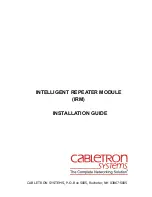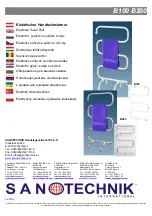
READ THIS ENTIRE SECTION BEFORE BEGINNING
TO TROUBLESHOOT PROBLEMS.
The following troubleshooting guide provides procedures for
isolating equipment problems. This guide is intended for
use by a QUALIFIED GAS HEATER SERVICE PERSON.
DO
NOT ATTEMPT TO SERVICE THESE HEATERS UNLESS YOU
HAVE BEEN PROPERLY TRAINED.
TEST EQUIPMENT REQUIRED
The following pieces of test equipment will be required to
troubleshoot this system with minimal time and effort.
• Digital Multimeter
- for measuring AC voltage and
resistance.
• Low Pressure Gauge
- for checking inlet and outlet
pressures at the gas control valve against dataplate
rating.
■
Visually inspect equipment for apparent damage.
■
Check all wiring for loose connections and worn
insulation.
Refer to the system operation sequence in this section to
gain an understanding as to how the equipment operates
during a call for heat. Understanding the sequence of
operation of the ignition module and related components is
esential as it will relate directly to problem solving provided
by the flow charts.
The ignition control module is self-diagnostic. The red LED
on the burner box will flash a specific light pattern
depending upon the problem which is diagnosed. To
effectively use the flow charts, you must first identify what
the problem is by the light pattern of the red diagnostic light.
If the light is flashing, the flash pattern will be followed by a
pause and then a repeat of the flash pattern until the
problem is corrected. Refer to the tables below to identify
what page to refer to when troubleshooting any problems.
Problems
Page
L.E.D. is steady on. No flash pattern.. . . . . . . . . . . . . . . . 24
L.E.D. light is not on. . . . . . . . . . . . . . . . . . . . . . . . . . . . . . 24
L.E.D. diagnostic light is flashing:
A. One Time. . . . . . . . . . . . . . . . . . . . . . . . . . . . 25
B. Two Times . . . . . . . . . . . . . . . . . . . . . . . . . . . 25
C. Three Times . . . . . . . . . . . . . . . . . . . . . . . . . 26
D. Four Times . . . . . . . . . . . . . . . . . . . . . . . . . . 26
E. Five Times. . . . . . . . . . . . . . . . . . . . . . . . . . . 26
Components should be replaced only after each step has
been completed and replacement is suggested in the flow
chart. Refer to the Servicing sections as necessary to
obtain information on disassembly and replacement
procedures of the component once the problem is identified
by the flow chart.
DIRECT IGNITION OPERATION SEQUENCE:
-- Line voltage is sent to ignition control and to
transformer.
-- Transformer reduces line voltage to 24 volts which is
sent to thermostat.
-- The thermostat calls for heat.
-- The thermostat sends 24 volts to ignition control.
-- Red light is illuminated.
-- Ignition control module performs self safety check.
-- Internal components are tested.
-- Air pressure switch circuit is checked.
-- Ignition control module begins ignition trial sequence.
-- Ignition control module sends 24 volts to air pressure
switch.
-- Ignition control sends line voltage to motor.
-- Fan motor starts.
-- Air pressure switch contacts close and 24 volts are
returned to the ignition control module.
-- Ignition control module sends high voltage to the igniter
electrode.
-- Igniter sparks.
-- Ignition control module sends 24 volts to the gas control
valve.
-- Gas control valve opens.
-- Ignition occurs.
-- Igniter continues to spark until flame proving
occurs.
-- Ignition spark is cut off.
-- Gas valve stays open.
-- Second stage (if applicable) of gas control opens
based upon thermostat.
-- Room warms to desired temperature.
-- Thermostat is satisfied.
-- Heater shuts down.
-- Process starts again on a call for heat.
Troubleshooting Information
WARNING
■
This heater can start at any time.
■
Troubleshooting this system may require operating the
unit with line voltage present and gas on. Use extreme
caution when working on the heater.
■
Failure to follow this warning may result in property
damage, personal injury or death.
23










































